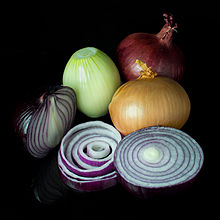**Taxonomy, History, and Cultivation**:
– The onion plant is scientifically known as Allium cepa, belonging to the genus Allium.
– Domestication likely took place in West or Central Asia, with ancient records of onion use in western and eastern Asia.
– Onions are harvested when foliage dies down, prone to pests like onion fly and diseases such as white rot.
– Some A. cepa varieties produce multiple bulbs, and they are known exclusively from cultivation.
**Uses and Culinary Applications**:
– Onions are consumed worldwide, raw or cooked in various dishes, used to make pickles, chutneys, and in various culinary techniques.
– They are available in forms like fresh, frozen, canned, caramelized, pickled, and chopped.
– Onions can be baked, boiled, grilled, fried, roasted, sautéed, or eaten raw, with different varieties offering culinary versatility.
**Health, Nutrition, and Chemical Composition**:
– Onions are low in essential nutrients but contribute savory flavor without many calories.
– They contain unique dietary flavonoids, with different varieties having varying phytochemical contents.
– Research on onion compounds includes chemical structures of pigments, health benefits, and gene silencing techniques for tearless onions.
**Varieties, Cultivation Practices, and Storage**:
– Different onion types have varying day-length requirements for bulb growth, with common onions having economic importance.
– Storage practices vary, with recommendations for different onion types like cooking onions and sweet onions.
– Varieties include dry bulbs, salad onions, and pickling onions, catering to various culinary preferences.
**World Production, Education, and Miscellaneous Uses**:
– In 2021, global production of onions and shallots as green produce was 4.6 million tonnes, with China leading production.
– Onions are used in education for cell structure demonstrations and dye purposes using onion skins.
– Miscellaneous uses include onion oil for pesticide purposes, dye production from onion skins, and onions being a significant crop worldwide.
An onion (Allium cepa L., from Latin cepa meaning "onion"), also known as the bulb onion or common onion, is a vegetable that is the most widely cultivated species of the genus Allium. The shallot is a botanical variety of the onion which was classified as a separate species until 2011. Its close relatives include garlic, scallion, leek, and chive.
| Onion | |
|---|---|

| |
| A display of commercially-grown bulbs, including red and yellow cultivars. | |
| Scientific classification | |
| Kingdom: | Plantae |
| Clade: | Tracheophytes |
| Clade: | Angiosperms |
| Clade: | Monocots |
| Order: | Asparagales |
| Family: | Amaryllidaceae |
| Subfamily: | Allioideae |
| Genus: | Allium |
| Subgenus: | A. subg. Cepa |
| Species: | A. cepa
|
| Binomial name | |
| Allium cepa | |
| Synonyms | |
|
Species synonymy
| |
This genus also contains several other species variously referred to as onions and cultivated for food, such as the Japanese bunching onion Allium fistulosum, the tree onion Allium × proliferum, and the Canada onion Allium canadense. The name wild onion is applied to a number of Allium species, but A. cepa is exclusively known from cultivation. Its ancestral wild original form is not known, although escapes from cultivation have become established in some regions. The onion is most frequently a biennial or a perennial plant, but is usually treated as an annual and harvested in its first growing season.
The onion plant has a fan of hollow, bluish-green leaves, and its bulb at the base of the plant begins to swell when a certain day-length is reached. The bulbs are composed of shortened, compressed, underground stems surrounded by fleshy modified scale (leaves) that envelop a central bud at the tip of the stem. In the autumn (or in spring, in the case of overwintering onions), the foliage dies down and the outer layers of the bulb become more dry, and brittle. The crop is harvested and dried and the onions are ready for use or storage. The crop is prone to attack by a number of pests and diseases, particularly the onion fly, the onion eelworm, and various fungi which can cause rotting. Some varieties of A. cepa, such as shallots and potato onions, produce multiple bulbs.
Onions are cultivated and used around the world. As a food item, they are usually served raw,[citation needed] as a vegetable or part of a prepared savoury dish, but can also be eaten cooked or used to make pickles or chutneys. They are pungent when chopped and contain certain chemical substances which may irritate the eyes.
